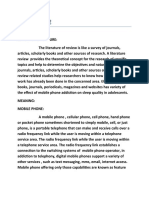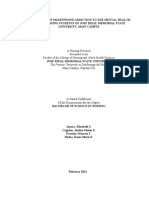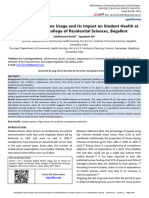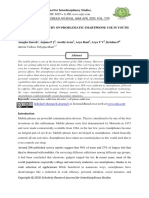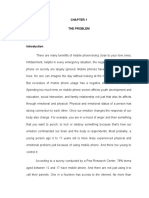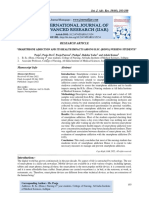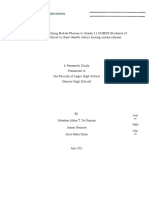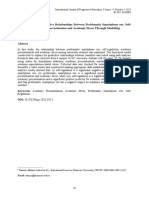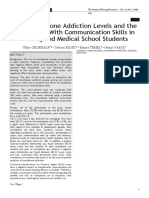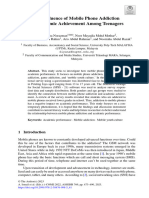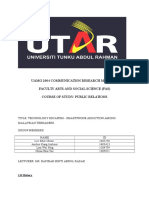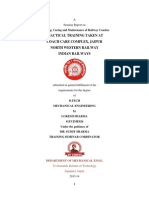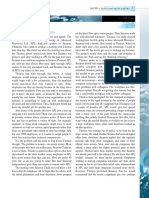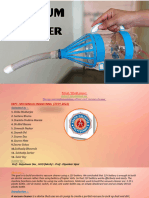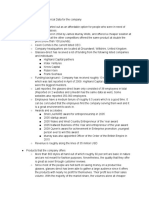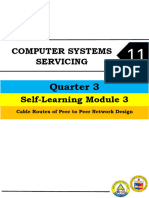A STUDY OF SMART PHONE ADDICTION
AMONG SECONDARY SCHOOL STUDENTS
INTRODUCTION
Technology came into the existence a very long time, but in the 21st century, it started to expand rapidly.
As a result, the changes we can see in the world are still the best changes so far. The transformation and
development of technology that not only improves our communication system but also makes our
lifestyle a lot easier than never anybody can dream of. The unique invention of this technology is the
mobile. We cannot think of living life without mobile phones in the present day. In India, approximately
every person seems to have one. This mobile can be seen from a rickshaw puller to a high trader.
Nowadays mobile phone is not just used for communication, in addition, mobile phones allow people to
access different types of content, and for example, weather update, news report, educational
information, sports content, music videos and much more. Technological appliances are now very useful
for higher education such as a laptop, desktop, mobile, tablet, note etc. As we know that mobile is very
much used by students and they also used it for gathering information. Generally, it is easily accessible
for everyone, because of the low price than other technological equipment’s and it can be easily moved
anywhere.
Studies have proven that rampant use of social networking, texting and chatting on mobile phones result
in lower grades and poor academic performance of students. While people of various ages find mobile
phones convenient and useful, younger generations tend to appreciate them more and be more
dependent on them. The researches proven that some students have the habit of keeping their mobile
phones on during classes and studies, even in the library, thereby distracting others.
Smartphone is a mobile phone with advanced computing ability, combining the functions of a
multimedia player (allowing for music/video storage and playback) and a personal digital assistant
(PDA), offering mobile Internet. connectivity, built-in GPS and camera, and the ability to run a wide
variety of third-party applications (such as games, communication software, applications offering
weather or traffic information etc. Smart phones have now become an essential part of life. However,
despite the convenience it brings to use, sometimes it might affect our daily life in a negative sense. One
of the typical examples is the overuse of smart phone. Smartphone can easily get our attention and
�distracts us. People, especially students, therefore are easily overusing the smart phone. The distractions
lower students’ productivity and take their time. It also lowers the quality of the work done. Today
mobile phone has occupied the place like our daily necessities. It is essential for different types of
works. In this context, it can be said that the efficiency of the mobile phone has increased due to fast
internet connectivity. As its being small for that it can be taken anywhere, and easily collects a lot of
information. Our education system has a specific time and it is not possible to answers all the questions
of the students within this time period.
Additionally, other journals and books issued by commercial organizations do not have a control unit
including editors and referees. Many of the sites on the Internet enable anybody to submit any kind of
information without being controlled, and many of the sites known as reliable are restricted to open
access for commercial purposes or security requirements (IP restriction, membership). This limits the
accessibility for students and deprives them of these sites. Frequent mobile use affects human
physiology and socialization. Not all researchers agree that there is such a thing as smart phone
addiction, and others think “addiction” is an inappropriate term to describe the disordered behaviours
associated with excessive smart phone use. While the condition is characterized more by the addictive
behaviours, such as replacing friends with social networking, addicted individuals might spend an
average of 38 hours a week online for personal use. Addiction refers to irrepressible urge which is often
accompanied by loss of control. Hence, smart phone addiction imparts that peoples develop problems
from their uncontrollable abuse of smart phone usage which is associated with other pathologies such as
depression, loneliness and social anxiety. Indeed, the impact of smart phone addiction recognized as the
bundle of dilemma such as; psychological aspects, interpersonal, physical, work and behavioural
problems.
SMARTPHONE ADDICTION:
The concept of addiction is not easy to define, and the usage of the term addiction has been considered
controversial; however, central to its definition is the dependence on a substance or activity. Smartphone
addition (SA) is generally conceptualized as a behavioural addition including mood tolerance, salience,
withdrawal modification, conflict, and relapse. Literature suggests that there are associations between
SA and mental health, physical health, and neurological problems. Furthermore tolerance, salience,
withdrawal, and cravings have been associated with excessive smart phone use. However, the evidence
is not conclusive. Still, there is debate in the literature about the positive or negative relationship
between the amount of screen time or smart phones use and health outcomes.
�Smart Phone addiction is a behavioural addiction that is characterized as being overly concerned about
social media, driven by an uncontrollable urge to log on to or use Smart phone, and devoting so much
time and effort to social media that it impairs other important life areas. Smartphone addiction is a
disorder involving compulsive overuse of the mobile devices, usually quantifies as the number of times
users access their devices and/or the total amount of time they are online over a specified period.
REVIEW OF LITERATURE
SMARTPHONE ADDICTION
Lee J, and Kim W (2021) conducted the study on smartphone addiction by Korea Internet and Security
Agency (KISA) with hypothesis to test basic personal data and smartphone using information were
analysed using machine learning techniques (decision tree, random forest, and Xgboost). They used a
machine learning approach for prediction of problematic smartphone use, around 29712 respondents
were included in the study with total 27 variables were analyses to predict the smartphone addiction
among that the highest rate 82.59% found by the random forest model and the lowest rate 74.56% found
to be decision tree model. The demographic data of age, gender and job found not associated with
problematic smartphone use.
Domoff SE, Sutherland EQ et al. (2020) in their study about Adolescents' Addictive Phone Use:
Associations with Eating Behaviours and Adiposity in USA. The study concerned on excessive or
"addictive" phone use among adolescents, and the impact that addictive phone use (APU) can have on
adolescent development and health. They examined the association between APU and emotion
regulation difficulties, impulsivity, maladaptive eating behaviours, and adiposity in a sample of 111
adolescents and found that APU is associated with greater emotion regulation. difficulties, dysregulated
eating, restrained eating, food addiction, and higher percent body fat. Further, they found that emotion
regulation difficulties mediated the association between APU and dysregulated eating, restrained eating,
and food addiction. Findings suggest that addictive phone use may confer increased risk for obesogenic
eating behaviours and food addiction via challenges in regulating emotions.
�Azam, Ali, Matiullah & Perveen (2020) conducted a study on systemically reviewed physical activity,
sports participation, and smartphone addiction in adolescent. Student ‘s prevalence of smartphone
addiction has grown rapidly in recent years that raise serious health concerns around the globe. A
systematic procedure of search was carried out to find the relevant literature within major research
databases. Studies found relevant to the topic were critically evaluated against the eight-point quality
assessment tool. The final appraisal resulted in the selection of 8 cross-sectional studies. Based on the
cross-sectional studies, we found consistent support for positive outcomes of physical activity or sports
participation on smartphone addiction among adolescent and the young student population. This review
study concluded that smartphone addiction can be reduced by increasing sports participation and
involvement in physical activity/exercise among adolescents and youth.
Gao, Jia et al. (2020) in their study on smartphone use disorder in youth was associated with severe
physical, psychological, and financial problems examined a wide range of psychosocial characteristics
in elementary-, middle-, and high-school adolescents with high scores on smartphone use disorder.
Regression-based analytical techniques, found that gender, self-control, sensation seeking, loneliness,
anxiety, perceived parent-adolescent relationship, and perceived parental monitoring are associated with
smartphone use disorder. To complement traditional variable cantered approaches, the current study
adopted a person-centred approach, fuzzy-set Qualitative Comparative Analysis (fsQCA) procedures, to
examine adolescents with smartphone use disorder. A comparison across the three educational levels
revealed four differences and two similarities. The results suggest that different groups of adolescents
might be at risk for smartphone use disorder across the three educational levels. The results suggest that
educators and mental health practitioners should consider educational level when helping adolescents
with smartphone use disorder.
Liui X, Wang S et al. (2020) conducted a study on attention bias training for reducing smartphone
addiction in Chinese college students. They studied whether attention bias training (ABT) can
effectively reduce attention bias (AB) and the degree of smartphone addiction and promote improved
behavioural and emotional states among college students. 33 participants with scores ≥77 on the
Smartphone Addiction Scale for College Students (SAS-C) were randomly divided into ABT and
attention control (AC) groups. They used the modified dot-probe task to train attention once a day for 6
days. Results showed that the reaction times (p = .004, η2 = .131), AB (p < .001, η2 = .379), and
smartphone addiction (p = .043, η2 = .133) of the ABT group were reduced compared to the AC group
post training, and emotional regulation ability (p = .095, η2 = .093) was marginally improved. Seventy
�five percent of the ABT group no longer met the criteria for smartphone addiction, compared with forty-
six percent of the AC group. Irrespective of training condition, participants ‘daily smartphone usage
time decreased. This suggests that ABT can reduce AB and the severity of smartphone addiction in
college students and improve emotional regulation ability to a lesser extent.
Mohamed S and Mostafa M, (2020) conducted a cross-sectional, survey-based study on the Impact of
smartphone addiction on depression and self-esteem among nursing students Stratified random sample
consists of 320 nursing students with four tools used for data collection includes personal data sheet,
Hamilton rating scale of depression, smartphone addiction scale and Self-esteem Inventory. About
95.8% of nursing students reported smartphone addiction, while 32.5% were pseudo normal of
depression. Twenty-eight percent of them had low self-esteem. The study also revealed a statistically
significant positive correlation between smartphone addiction and levels of depression. There was a
statistically significant negative correlation between levels of depression and self-esteem.
Tangmunkongvorakul A, Musumari PM, et al. (2020) conducted a study on factors associated with
smartphone addiction: A comparative study between Japanese and Thai high school students. Study
aimed to address this research gap by presenting a comparative analysis of factors associated with
smartphone addiction in Japan and Thailand. This study included a total of 7694 students, 6585 students
from Japan and 1109 students from Thailand. The prevalence of smartphone addiction was 35.9%
among Thai students and 12% among Japanese students. Thai students were more likely to have
smartphone addiction than Japanese students (AOR 2.76; 4 95% CI : 2.37–3.30). Smartphone addiction
was more prevalent among Thai adolescents than Japanese adolescents, and more prevalent among
females than males in both countries. Interventions for reducing smartphone addiction should take into
account both context and gender, and should leverage the protective effect of parental connectedness.
Ganapathy S and Monisha R (2020) conducted a study on evaluation of smartphone addiction and
quality of sleep among school children in private schools and colleges around Kancheepuram.
Convenient sampling method was used to enrol the 100 participants and they were in age range from 13-
17 years. Smartphone are devices that have the capability to process information, store information and
enable communication. They include a variety of features such as access to internet, social media,
videos, multimedia, navigations and many more. Internet addiction and smartphone addiction can most
often be confused and the purpose of the study was to identify children with smart phone addiction and
�non- addiction and their sleep quality. SPAI- Smart phone addictive inventory is a valid and reliable
mean to identify and measure smart-phone addictions and in the current study we used SPAI to identify
children with smart-phone addiction and non-addiction and the PSQI Scale was used to identify sleep
quality in students and the study concludes that there is a significant correlation in poor sleep quality
among students with smart-phone addiction.
RATIONALE
The smart phone has become an essential part of modern life, with people of all ages spending
significant amounts of time online. However, excessive and problematic smartphone use, or smartphone
addiction, is increasingly recognized as a significant public health issue, particularly among adolescents
and young adults. In recent years, there has been growing concern about the impact of Smartphone
addiction on the mental health and well-being of secondary school students.
Studies have shown that Smartphone can lead to a range of negative outcomes, including academic
problems, social isolation, sleep disturbance, anxiety, depression, and even suicidal ideation. Secondary
school students are particularly vulnerable to smartphone addiction due to their developmental stage,
social and academic pressures, and the widespread availability of Internet-enabled devices.
Despite the growing concern about smartphones addictions in secondary school students, there is a lack
of research on this topic in many parts of the world, including India. Therefore, this study aims to
investigate the prevalence and correlates of smartphone addiction in a sample of secondary school
students in Haridwar Uttarakhand. By understanding the extent and nature of smartphones addiction
among this population, this study seeks to inform the development of effective prevention and
intervention strategies to address this important public health issue.


